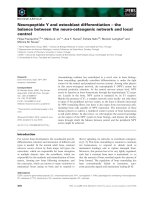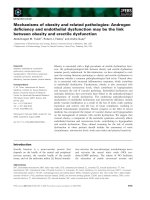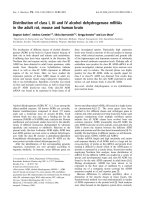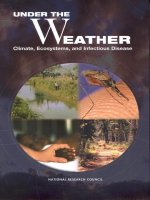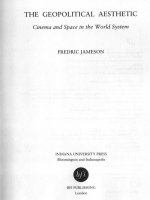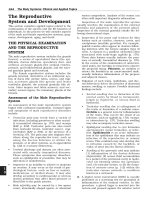The Society for Cinema and Media Studies’ Statement of Best Practices for Fair Use in Teaching for Film and Media Educators ppt
Bạn đang xem bản rút gọn của tài liệu. Xem và tải ngay bản đầy đủ của tài liệu tại đây (70.97 KB, 10 trang )
The Society for Cinema and Media Studies’
Statement of Best Practices for Fair Use in
Teaching for Film and Media Educators
Introduction. The field of film and media studies in the United States was
shaped by the legal principle of fair use—the ability of educators, critics, and oth-
ers to teach, study, and write about media without having to ask copyright holders
for permission every time their works are used. Educational and critical uses of
media, such as those employed by film and media educators, are woven into the
fabric of a free, democratic society, and lead directly to the continued health and
creative vibrancy of both commercial and non-commercial film and media. There
are two main barriers to the full exercise of lawful uses of media by film and media
educators. First, many film and media educators lack a basic understanding of
copyright law, particularly of the framework through which they may make legal,
non-infringing uses of another’s work. Second, vagueness in the law has resulted
in a lack of consensus among educators regarding permissible practices and a con-
fusing patchwork of policies, guidelines, and actual uses. In light of these two bar-
riers, it is unsurprising that academic gatekeepers (libraries, university general
counsels, IT staffs, etc.) frequently choose to adopt overly cautious and conserva-
tive copyright policies that sometimes result in a diminished educational experi-
ence for film and media students.
The Society for Cinema and Media Studies (SCMS) has created this State-
ment of Best Practices for its membership to clarify some of the issues concern-
ing the permissible use of media for teaching. Note that this statement explains
and clarifies United States copyright laws and policies, as over 85% of SCMS
survey respondents teach within the U.S. SCMS members teaching in other coun-
tries should consult with local experts as to how these guidelines might apply in
other parts of the world. This statement is informed by statutory provisions and
their legislative histories, analogous case law, and current professional practices
based on a survey conducted by the SCMS Public Policy Subcommittee and input
from members of the subcommittee. The online survey was administered using
SurveyMonkey.com. It generated 659 responses over 10 days in Spring 2007, rep-
resenting approximately 30% of SCMS membership, polled the current practices
of SCMS members and asked for comments and feedback concerning the issue of
copyrighted material and film and media pedagogy. The survey focused on the
sources used to obtain course material, the screening of that material, and the cre-
ation of compilations for instructional purposes and student uses. SCMS has at-
tempted to use the information it gained through the survey to compile, analyze,
and evaluate common practices of film and media educators. The final report was
reviewed and approved by the SCMS Board of Directors.
Cinema Journal 47, No. 2, Winter 2008 155
© 2008 by the University of Texas Press, P.O. Box 7819, Austin, TX 78713-7819
Fair_Use.qxp 2/4/08 8:36 AM Page 155
SCMS’s Statement sets out to accomplish four specific goals:
1. To provide practical assistance to film and media educators in determining
whether a particular use of a work is permissible;
2. To provide a guide for publishers, universities, and other gatekeepers or in-
surers to support the work of film and media educators;
3. To deter copyright owners from taking unfair or intimidating action; and
4. To formalize customary practices that over time can help guide courts in de-
termining what types of uses are generally accepted as non-infringing by film
and media educators.
The Concepts of Copyright and Fair Use. The freedom of film and media
educators to use audiovisual works in their courses—and the limits on such use—
are rooted in existing copyright laws. Copyright law provides owners of copy-
righted works a number of limited rights, including the right to exclude others
from reproducing, performing, displaying, and distributing their works. The law
also gives copyright owners the right to exclude others from preparing derivative
works from their original works, including translations, adaptations, and compila-
tions. In many cases, if someone engages in any of these activities without the per-
mission of the copyright owner, that person may be infringing on the owner’s rights
and may thus be held liable for damages.
In the interest of balancing copyright owners’ rights against potentially bene-
ficial uses of the works by others, copyright law has imposed a number of restric-
tions on these rights. These restrictions serve as “safe harbors” for educators by
allowing certain uses of protected works that do not infringe copyright holders’
rights. There are three important safe harbors of particular interest to film and
media educators: the doctrine of fair use, the exception for face-to-face teaching
activities, and the exception for online distance education. The fair use doctrine
affords the broadest protection for use of copyrighted materials because it is a gen-
eral and flexible standard. In general, fair use allows people to use copyrighted
materials without authorization for purposes such as “criticism, comment, news
reporting, teaching (including multiple copies for classroom use), scholarship, or
research,” so long as their use qualifies as a “fair use” in light of the four factors set
out in 17 U.S.C. § 107:
1. The purpose and character of the use, including whether such use is of a com-
mercial nature or is for nonprofit educational purposes;
2. The nature of the copyrighted work;
3. The amount and substantiality of the portion used in relation to the copy-
righted work as a whole; and
4. The effect of the use upon the potential market for or value of the copy-
righted work.
The Copyright Act specifically recognizes that uses of copyright works for the
purposes of teaching and criticism are the kinds of uses that the fair use doctrine
156 Cinema Journal 47, No. 2, Winter 2008
Fair_Use.qxp 2/4/08 8:36 AM Page 156
is intended to protect. Under the first factor, if the “purpose and character of the
use” is non-profit educational activity, it would tend to weigh heavily in favor of
the use being fair and non-infringing. However, not every educational and non-
commercial use is non-infringing; fair use analysis requires examining all of the
factors relative to the others and in view of the overall aims of U.S. copyright law.
Further, different courts have emphasized different factors at different times. The
second factor asks users to consider “the nature of the copyrighted work.” Gener-
ally, creative works are afforded greater protection than purely factual works. The
third factor depends on the “amount and substantiality of the portion” borrowed
from the overall copyrighted work, taking into account whether more of the work
was used than necessary to accomplish the specific purpose of the use. The fourth
factor examines “the effect of the use upon the potential market for or value of
the work.” In the educational context, this factor protects the copyright owners’
financial interests in being able to create and sell works to educational institutions,
educators, and students. If the audiovisual work being used by an educator was
specifically marketed for classroom use and the use would substitute for pur-
chases or licenses that otherwise would be likely to occur, it would tend to weigh
against it being fair use and the educator may have to obtain formal permission for
such use.
Educators may also rely on the face-to-face classroom exception and the on-
line distance education exception to protect educational uses of media. Educa-
tors may seek protection under these exceptions when their use meets their
respective requirements. However, even if their particular use is not covered by
one of the exceptions, it may still qualify as a “fair use” under the four factors out-
lined above.
It is important to note that neither the educational exceptions nor the
statute’s definition of fair use delineate specific permissible uses. As a result, it is
somewhat unclear exactly which uses they protect and every use is subject to indi-
vidual analysis. Thus, this statement does not attempt to establish specific prac-
tices that would be protected under current copyright law. Instead, it outlines
basic copyright principles regarding educational use. It also describes prevalent
practices in the community of film and media educators that are believed to be fair
uses or otherwise permissible without copyright holder authorization. The State-
ment identifies five broad principles for use of film and media in U.S. classrooms
and then sets out limitations and clarifications regarding certain uses. The stated
principles are critical to ensure a thriving film and media educational curricula
which in turn will support the growth of the field of film and media studies.
Principle I: Classroom Screenings
The practice of screening excerpts or entire works within the face-to-face teach-
ing context is well established, requiring no permission or payment. A face-to-face
teaching context involves educators being in the same general place as their stu-
dents during the display and performance of copyrighted works. The space itself
Cinema Journal 47, No. 2, Winter 2008
157
Fair_Use.qxp 2/4/08 8:36 AM Page 157
does not have to be an actual classroom and may include other places used for
instruction, such as a gymnasium, auditorium, or library. Educators using film and
media for instructional purposes within the face-to-face teaching context require
great latitude to display, perform, and reproduce copyrighted works. They rou-
tinely utilize still images, film and video clips, video games, audio segments, and
other media for the purposes of analyzing and illustrating historical, theoretical,
and critical ideas. In many cases, educators need to use complete works, either in
class or during separate screening times. Educators have been doing this at U.S.
universities for many decades. This understanding of the fair use doctrine seems
to be supported by current practices, as at least 70% of SCMS survey respondents
reported that they screen materials for courses without formally securing permis-
sions from rights holders.
Limitations & Clarifications
Lawfully Made Copies: The practice of screening works falls squarely within
the face-to-face teaching exception so long as the copy of the work used for such
instruction was lawfully made and it was screened in an appropriate location, as
described above. A copy is lawfully made if: (1) it is reproduced with the permis-
sion of the copyright holder; or (2) it is reproduced such that it falls within the fair
use exception. It may be purchased, rented, reproduced, or borrowed by the per-
son using the work or by anyone else. Thus, a library copy, a student’s copy, or an-
other professor’s copy could all be considered lawfully made. It is important to
note, however, that even if the copy was unlawfully made, the performance or dis-
play of the work may still fall within the exception if the educator did not know or
have reason to know of that fact.
Screenings: In some cases, film and media educators may be required to obtain
licenses for certain screenings of audiovisual works. A license may be required for
classroom screenings that are advertised to persons who are not enrolled in the
course or that require an admission charge beyond the regular tuition and fees for
the course. A license may also be required for screenings aimed at entertainment
rather than educational purposes. Many films and videos directed at an educa-
tional market may be rented with licenses that permit their screening or broadcast
outside of the classroom. There are also a number of rights clearinghouses that
may be contacted to secure licenses for such use. It is important to remember,
however, that even when the audience for the screening extends beyond the class-
room or admission is charged, educators’ screening of the material may still qual-
ify as a fair use under the Copyright Act.
Distribution to Students: Copyrighted media may also be made available to
students for further study through library or departmental reserves. In addition,
such works may be distributed online, provided that the requirements of the on-
line distance education exception are satisfied or the use qualifies as a fair use
under the Copyright Act. See the discussion in Principle IV regarding the online
distance education exception for further information.
158 Cinema Journal 47, No. 2, Winter 2008
Fair_Use.qxp 2/4/08 8:36 AM Page 158
Principle II: Broadcast Recordings
Film and media educators routinely record radio and television broadcasts for use
in their classrooms. These recordings are often retained in personal or university
libraries for the purposes of teaching and study. SCMS believes these recordings
can be retained indefinitely, used for subsequent courses, and qualify as fair use.
Limitations & Clarifications
Previous Broadcast Guidelines: The community of film and media educators
believes that fair use of recorded broadcast programs in the classroom is not lim-
ited by the restrictions laid out in the “Guidelines for Off-Air Recording of Broad-
cast Programming for Educational Purposes,” which were issued in 1981 and are
available through the Copyright Office at />.pdf. Although the guidelines impose some restrictions on such copying, they are
not binding, have never been relied on by a court, and have not been widely
adopted by universities nor enforced by copyright owners. The guidelines also
may have been superseded by the decision in Sony Corp. of America v. Universal
City Studios, Inc., 464 U.S. 417 (1984). The Sony decision made the recording of
broadcast television programming for personal use lawful as a fair use. Accord-
ingly, such copies should meet the “lawfully made” requirement if later used in the
classroom under the face-to-face teaching exception, even if they do not meet the
broadcast guidelines.
Highly Organized, Large-Scale, and Systematic Reproduction: The highly
organized, large-scale, and systematic reproduction of copyrighted works that are
originally recorded from broadcast television may not be permissible regardless of
whether such recordings are intended for non-profit educational use. For exam-
ple, in Encyclopedia Britannica Educational Corp. v. Crooks, 542 F. Supp. 1156
(1982), a court held that the fair use doctrine did not protect the activities of the
Board of Educational Services in Erie County, New York, which made mass copies
of copyrighted works taped off of broadcast television for distribution to educa-
tors. The use was held to be infringing despite the fact that the original works were
not specifically marketed to educators. Such mass reproduction is not likely to be
a fair use because it may harm the general marketability of the copyrighted works
by impacting their potential sales and hindering their entry into or standing in the
educational market.
Principle III: Derivative Works
It is often necessary for educators to copy excerpts from films, television shows,
and other media and include them in compilations or presentations for illustrative
purposes. The ability to copy, excerpt and edit, capture stills, and manipulate im-
ages and sounds in this way enhances film and media educators’ ability to analyze,
critique, and teach media. The community of film and media educators believes
that such practices qualify as fair uses of copyrighted works.
Cinema Journal 47, No. 2, Winter 2008
159
Fair_Use.qxp 2/4/08 8:36 AM Page 159
In addition, students need latitude for using copyrighted media for classroom
presentations or other course assignments. More than half of the SCMS survey re-
spondents reported that they assign students projects that may include incorporat-
ing clips into their work. Students need the same access to the tools of criticism,
analysis, and demonstration as educators. Specifically, they may need to repro-
duce, manipulate, and remix media as a part of a course. SCMS believes such stu-
dent uses are fair uses so long as the excerpts are used in the service of coursework
or study and are not circulated beyond the class.
Limitations & Clarifications
Anti-Circumvention: The 1998 Digital Millennium Copyright Act (DMCA)
amended U.S. law by including an “anti-circumvention provision” to prohibit by-
passing technological measures on digital media that effectively control access to
that media, such as on most commercial DVDs and iTunes music and videos.
This prohibition presented a problem for film and media educators because dig-
ital copies have become the standard for classroom use, but making digital copies
of DVDs and other technologically-protected media for such use requires by-
passing such technological measures. Although the text of the DMCA made clear
that it was not intended to restrict the fair use of copyrighted works, a fair use
claim does not exempt a use from the DMCA’s restrictions on circumventing
copy protection.
In 2006, however, the Library of Congress created an exemption to the
DMCA’s anti-circumvention provision specifically for film and media educators.
Media educators may now circumvent technological measures for such protected
works included in the educational library of a college or university’s film or media
studies department for the purpose of making compilations of portions of those
works for educational use in the classroom. This exemption is subject to renewal
in October 2009, at which time it may be expanded or modified. The community
of film and media educators believes that this exemption should be expanded to
allow students to similarly circumvent technological measures for classroom use,
as well as allowing educators to circumvent protection on materials acquired from
sources outside of a departmental educational library if they are using the work for
classroom use.
It is important to note that the DMCA’s limitation on circumvention of tech-
nological measures only applies to technologically-protected media where the un-
derlying work is subject to copyright protection. The anti-circumvention provision
thus does not apply to: (1) technologically-unprotected media; or (2) technologi-
cally-protected media where the underlying work is not protected by copyright
(i.e. works in the public domain). Further, if the technologically-protected work is
subject to copyright protection and the exemption does not apply, an educator still
has the option of translating the digital copy into an analog copy. This can be done
by recording the video and analog feed from a DVD player or a computer through
the analog out jack. However, the translation from digital to analog frequently
160 Cinema Journal 47, No. 2, Winter 2008
Fair_Use.qxp 2/4/08 8:36 AM Page 160
results in a severe degradation of image quality, which may make this method un-
acceptable in many instances.
Principle IV: Online Distance Education
The community of film and media educators is increasingly integrating the inter-
net into their curricula and pedagogy. Copyright law has evolved to recognize that
more and more individuals are accessing educational opportunities through the in-
ternet. Educators engaged in distance education teaching may rely on the general
protection afforded under the fair use doctrine or rely on the safe harbor of the
online distance education exception to create an educational experience for online
students that is comparable to that of their face-to-face classroom counterparts.
It is unclear whether the exception applies only to fully online courses or also
encompasses hybrid courses that have a traditional face-to-face classroom compo-
nent as well as an online component. Accredited, nonprofit educational institu-
tions can take advantage of the exception to perform and display a variety of film
and media works as part of their courses by understanding and managing the in-
stitutional, educator, and IT responsibilities imposed by the exception. While the
online distance education exception protects the use of materials by educators in
certain contexts, activities beyond the scope of the exception may still be protected
under the broader fair use doctrine.
Limitations & Clarifications
Online Distance Education Exception: Under the online distance education
exception, the requirements for the use of copyrighted material in online distance
education courses are much more specific and cumbersome than those of the face-
to-face classroom exception. The online distance education exception was amended
by the Technology, Education, and Copyright Harmonization Act (TEACH Act)
of 2002 in an effort to put the digital classroom on par with the traditional face-to-
face classroom setting. The amended online distance education exception allows
for: (1) display and performance of nearly all types of work; (2) transmission of
course content to students in any location over the internet; (3) temporary access
by students; and (4) digitization of analog works.
Currently, educators in the face-to-face teaching context enjoy more latitude
and face fewer restrictions under the face-to-face exception than do their counter-
parts in the distance education context under the online distance education excep-
tion. For example, while educators in the online distance education context may
only use “reasonable and limited portions” of an audiovisual work, educators in the
face-to-face context face no such limitation. While the responsibilities initially
seem overwhelming and confusing, they are not unmanageable. The TEACH Act
imposes responsibilities on three groups in particular: (1) institutional decision-
makers, (2) educators, and (3) IT specialists. Because the TEACH Act imposes a
number of technical requirements, most academic institutions have been reluc-
tant to employ the TEACH Act’s provisions or to draft TEACH Act policies.
Cinema Journal 47, No. 2, Winter 2008
161
Fair_Use.qxp 2/4/08 8:36 AM Page 161
162 Cinema Journal 47, No. 2, Winter 2008
Instead, they have continued to rely on copyright licensing and fair use to ensure
that their use is legally permissible. Although initial implementation of the
TEACH Act requires considerable commitment and resources, it may offer
greater predictability than just relying on the general fair use doctrine. The chart
in Appendix A is meant to simplify the various requirements of the TEACH Act
so that institutions and educators can better understand them and begin to imple-
ment them.
It is important to remember that the broader fair use doctrine may provide
additional protection of distance education activities beyond the scope of this
exception.
Principle V: Public Domain
A public domain work is a work that is not protected by copyright and which may
be freely used by everyone. There are no restrictions on copying or use of such
works under the Copyright Act or the DMCA. In general, public domain works in-
clude works for which:
1. The term of copyright for the work has expired;
2. The author of a work published before 1978 failed to satisfy statutory formal-
ities to perfect the copyright;
3. The copyright owner has dedicated the copyright term to the public; or
4. The U.S. Government is the source.
Educators may use a copyright term chart to calculate whether the copyright
term in a work has expired. One is available at: />training/Hirtle_Public_Domain.htm.
This Statement was prepared by the Society for Cinema and Media Studies
(SCMS). SCMS is a professional organization of college and university educa-
tors, filmmakers, historians, critics, scholars, and others devoted to the study of
the moving image. For further information, please visit SCMS’s website at www
.cmstudies.org. SCMS would like to thank the Glushko-Samuelson Intellectual
Property Law Clinic of the Washington College of Law for their assistance on this
project.
Fair_Use.qxp 2/4/08 8:36 AM Page 162
APPENDIX A
TEACH ACT RESPONSIBILITIES FOR DISPLAYING OR PERFORMING
FILM AND MEDIA IN ONLINE INSTRUCTION
Institutional Faculty Information Technology
Cinema Journal 47, No. 2, Winter 2008
163
Your institution must
be a government body
or an accredited
nonprofit educational
institution.
Your institution must
incorporate
institutional copyright
policies to educate
faculty, staff, and
students.
The institution must
disseminate
information about
copyright policies
and laws.
The institution must
provide notice to
students about
potential legal
limitations on the use
of materials used as
part of the online
course.
The institution must
limit access to the
materials to students
enrolled in the
specific online course.
Faculty may:
1. Perform nondramatic
literary works;
2. Perform nondramatic
musical works;
3. Perform any other work in
“reasonable and limited
portions”; and
4. Display any work “in an
amount comparable to that
which is typically displayed
in the course of a live
classroom session.”
Faculty must ensure that the
performance or display is:
1. Supervised—“made by, at
the direction of, or under
the actual supervision of an
instructor”;
2. Part of a structured
course—“an integral part
of a class session offered
as a regular part of the
systematic, mediated
instructional activities”
of the educational
institution; and
3. Relevant—“directly related
and of material assistance to
the teaching content of the
transmission,” not just for
entertainment purposes.
Faculty may not use:
1. Works that are specifically
produced or marketed
for distance education
contexts; and
IT specialists must help
ensure that access to
copyrighted materials is
limited to students enrolled in
the online distance course.
IT specialists must employ
reasonable measures to ensure
that students’ abilities to
receive, store, and transmit
the materials is limited.
Students should receive the
information in a form that
allows them to access or
receive the materials only for
the class session; they should
only be able to access the
information temporarily. They
should also not be able to
store or download the
materials beyond the class
session.
IT specialists must make
reasonable efforts to ensure
that their technology for the
online distance education
course does not interfere with
digital rights management
technology measures used by
copyright owners to control
their works, except where the
2006 exemption applies
(see above section on
anti-circumvention).
Fair_Use.qxp 2/4/08 8:36 AM Page 163
164 Cinema Journal 47, No. 2, Winter 2008
Sources: 17 U.S.C. 110(2); 117 U.S.C. 112(f ); />teach_summary.htm; />.html; />Institutional Faculty Information Technology
2. Copies that the educational
institution “knew or had
reason to believe” were not
lawfully made and acquired.
Faculty may not convert
materials from analog into
digital formats, except where,
as outlined in 17 U.S.C. §
112(f ):
1. The amount that may be
converted is limited to the
amount of appropriate
works (“reasonable and
limited portions” for
performances and “amount
comparable to that which is
displayed in the course of a
live classroom session” for
displays); and
2. A digital version of the work
is not “available to the
institution” or is secured
behind technological
protection measures.
IT specialists must restrict
retention/storage of the
materials to reasonably
necessary periods of time
sufficient to facilitate class
transmission and in such a way
that only enrolled students
may access them.
IT specialists may not retain or
copy digital transmissions if
they are for purposes other
than the educational purposes
outlined in Section 110(2).
Fair_Use.qxp 2/4/08 8:36 AM Page 164

